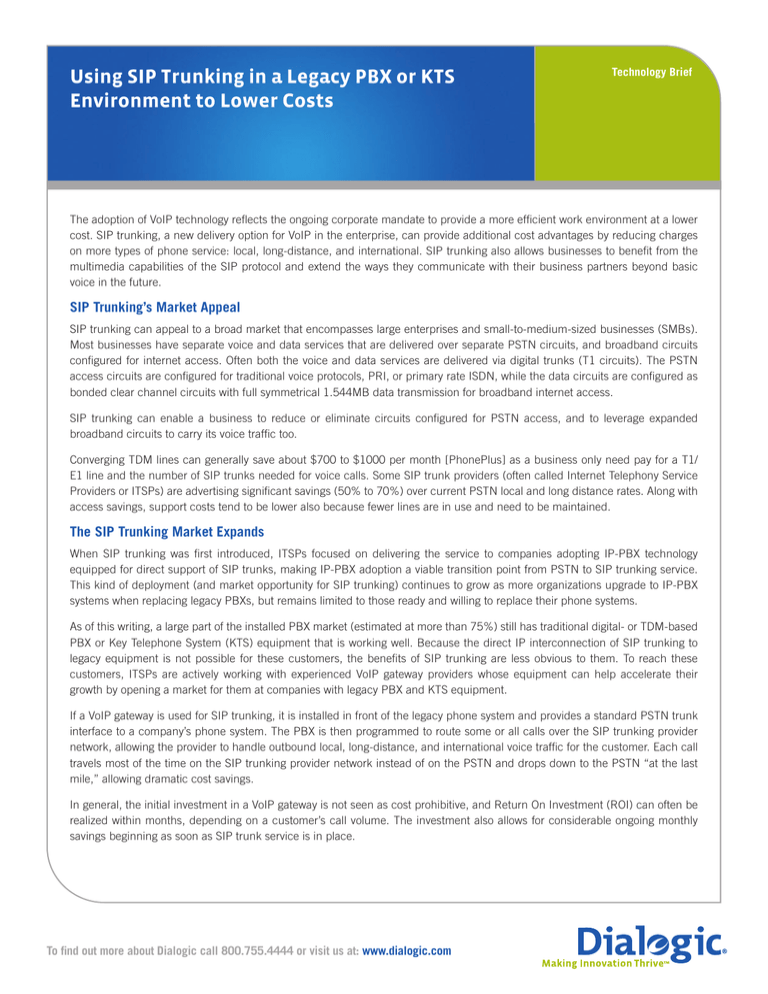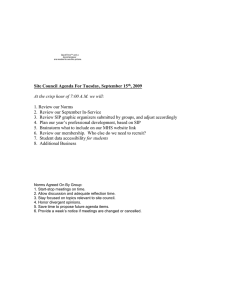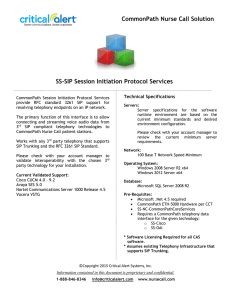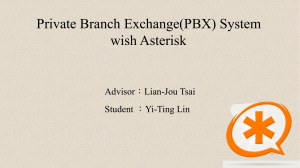
Technology Brief
Using SIP Trunking in a Legacy PBX or KTS
Environment to Lower Costs
The adoption of VoIP technology reflects the ongoing corporate mandate to provide a more efficient work environment at a lower
cost. SIP trunking, a new delivery option for VoIP in the enterprise, can provide additional cost advantages by reducing charges
on more types of phone service: local, long-distance, and international. SIP trunking also allows businesses to benefit from the
multimedia capabilities of the SIP protocol and extend the ways they communicate with their business partners beyond basic
voice in the future.
SIP Trunking’s Market Appeal
SIP trunking can appeal to a broad market that encompasses large enterprises and small-to-medium-sized businesses (SMBs).
Most businesses have separate voice and data services that are delivered over separate PSTN circuits, and broadband circuits
configured for internet access. Often both the voice and data services are delivered via digital trunks (T1 circuits). The PSTN
access circuits are configured for traditional voice protocols, PRI, or primary rate ISDN, while the data circuits are configured as
bonded clear channel circuits with full symmetrical 1.544MB data transmission for broadband internet access.
SIP trunking can enable a business to reduce or eliminate circuits configured for PSTN access, and to leverage expanded
broadband circuits to carry its voice traffic too.
Large Logo
Converging TDM lines can generally save about $700 to $1000 per month [PhonePlus] as a business only need pay for a T1/
E1 line and the number of SIP trunks needed for voice calls. Some SIP trunk providers (often called Internet Telephony Service
Providers or ITSPs) are advertising significant savings (50% to 70%) over current PSTN local and long distance rates. Along with
access savings, support costs tend to be lower also because fewer lines are in use and need to be maintained.
The SIP Trunking Market Expands
When SIP trunking was first introduced, ITSPs focused on delivering the service to companies adopting IP-PBX technology
equipped for direct support of SIP trunks, making IP-PBX adoption a viable transition point from PSTN to SIP trunking service.
This kind of deployment (and market opportunity for SIP trunking) continues to grow as more organizations upgrade to IP-PBX
systems when replacing legacy PBXs, but remains limited to those ready and willing to replace their phone systems.
As of this writing, a large part of the installed PBX market (estimated at more than 75%) still has traditional digital- or TDM-based
PBX or Key Telephone System (KTS) equipment that is working well. Because the direct IP interconnection of SIP trunking to
legacy equipment is not possible for these customers, the benefits of SIP trunking are less obvious to them. To reach these
customers, ITSPs are actively working with experienced VoIP gateway providers whose equipment can help accelerate their
growth by opening a market for them at companies with legacy PBX and KTS equipment.
If a VoIP gateway is used for SIP trunking, it is installed in front of the legacy phone system and provides a standard PSTN trunk
interface to a company’s phone system. The PBX is then programmed to route some or all calls over the SIP trunking provider
Medium Logo
network, allowing the provider to handle outbound local, long-distance, and international voice traffic for the customer. Each call
travels most of the time on the SIP trunking provider network instead of on the PSTN and drops down to the PSTN “at the last
mile,” allowing dramatic cost savings.
In general, the initial investment in a VoIP gateway is not seen as cost prohibitive, and Return On Investment (ROI) can often be
realized within months, depending on a customer’s call volume. The investment also allows for considerable ongoing monthly
savings beginning as soon as SIP trunk service is in place.
To find out more about Dialogic call 800.755.4444 or visit us at: www.dialogic.com
Using SIP Trunking in a Legacy PBX or KTS
Environment to Lower Costs
Technology Brief
Inbound call service can be transitioned to an ITSP as well, facilitating a complete transition away from a PSTN service provider.
Many ITSPs have developed a full suite of DID and toll-free services and remote exchange service, and they can help their
customers leverage number portability legislation to ease a transition.
Technical Considerations
In this section, we will discuss some technical considerations concerning bandwidth, gateway and PBX interoperability, and
Quality of Service (QoS).
Bandwidth
SIP trunks require approximately the same bandwidth as the traditional PSTN trunks they replace. SIP trunks running the G.711
coder (standard voice quality at 64 kbps) require a full Primary Rate Interface (PRI) span of clear channel service (1.544 mbps)
to deliver 18 simultaneous voice calls, compared to 23 channels for a single PRI running a TDM protocol such as NI2 over the
same link. If compression is raised using a G.729a coder, the number of simultaneous calls can be increased to about 28 per
clear channel PRI span.
Generally, the ITSP can provision service over an existing public internet broadband link used by a business, but bandwidth
requirements need to be considered. If an enterprise is already consuming all available broadband throughput for data, additional
internet broadband access provisioning is necessary to use SIP trunking (and should be considered when calculating ROI).
Gateway and PBX Interoperability
If a VoIP gateway is used for SIP trunk service, few changes are necessary for PBX or KTS environments. The gateway emulates
the PSTN Central Office trunk service, delivering T1/E1 PRI signaling and bearer channels to the PBX digital trunk ports. But if
new routing tables are established based on a mix of SIP trunk services and PSTN services, then changes would be required.
Interoperability testing is important, and should be considered before a gateway is purchased. Normally vendors do extensive
interoperability testing with leading PBX and KTS equipment, and with the access technology used by ITSPs because SIP
implementations still vary considerably.
Availability
One benefit offered by SIP trunking is its transparency to end users who dial into the converged system in the same way as into a
traditional system. Naturally, it is important for a converged service using SIP trunking to be as reliable as the system it replaces.
High levels of availability can be provided with a failover capability in the gateway. Failover allows calls to be routed over SIP
trunks when they are available, and to backup PSTN trunks if they are not or if the broadband link that services the SIP trunks is
unavailable. A gateway equipped with failover relays is required to provide failover availability, and a backup PSTN trunk service
must also be maintained. Both of these items will increase costs and must be factored into a company’s ROI calculations, but
such additional capabilities are considered essential for certain business applications such as a customer service center.
Using a VoIP Gateway for SIP Trunking
The Dialogic 2000 Media Gateway Series (DMG2000 Gateways) are very well-suited for use as VoIP gateways for SIP trunking.
They have been thoroughly tested for interoperability with leading PBX and KTS equipment, are field-proven, and two current
models in the series include failover technology. Dialogic is also in the process of testing the interoperability between the DMG2000
Gateways and the access technology used by leading ITSPs.
®
2
Technology Brief
Using SIP Trunking in a Legacy PBX or KTS
Environment to Lower Costs
PSTN
Legacy PBX
or KTS
ITSP
Connection
to PSTN
Optional PSTN
Failover
T1 Trunk
Circuit
Broadband Internet
Dialogic® 2000 Media Gateway
Series (DMG2000 Gateway)
External
Firewall
ITSP
Call Route
Failover Route
Data Network
Corporate LAN
Figure 1. DMG2000 Gateway Enables SIP Trunking Service
In Figure 1, a DMG2000 Gateway with a failover capability is shown in a sample configuration in which it enables SIP trunking as
a replacement for (or as a least-cost-routing option to) PSTN trunk service. The gateway is placed between a legacy PBX or KTS
and the broadband internet connection provisioned by the ITSP to relay calls, and between the PBX or KTS and a backup PSTN
line for failover. The PBX passes calls to the gateway in the same way as it would pass calls to its traditional PSTN Central Office
T1/E1 trunk service, and the gateway routes these calls using SIP to the broadband internet connection provisioned by the ITSP.
Failover relays in the gateway and additional T1/E1 ports provide a backup route to the PSTN if the SIP connection degrades or
is unavailable.
More Information about the Dialogic 2000 Media Gateway Series
®
For more information about gateways in the Dialogic 2000 Media Gateway Series (DMG2000 Gateways), visit
http://www.dialogic.com/products/gateways/DMG2000.htm.
Reference
[PhonePlus] Figure cited in Tara Seals, “SIPping into Something More Comfortable: SIP Trunking Offers Real SMB Opportunity”
(02/29/08) at http://www.phoneplusmag.com/articles/813/sip_trunking_offers_real_smb_opportunity.html
3
Small Logo
www.dialogic.com
Dialogic Corporation
9800 Cavendish Blvd., 5th floor
Montreal, Quebec
CANADA H4M 2V9
© 2009 Dialogic Corporation. All rights reserved. Dialogic is a registered trademark of Dialogic Corporation (“Dialogic”). Dialogic’s trademarks may be used publicly only
with permission from Dialogic. Such permission may only be granted by Dialogic’s legal department at the address provided above. The names of actual companies and
products mentioned herein are the trademarks of their respective owners.
Dialogic encourages all users of its products to procure all necessary intellectual property licenses required to implement their concepts or applications, which licenses
may vary from country to country. None of the information provided herein forms part of the specifications of the product(s) and any benefits specified are not guaranteed.
No licenses or warranties of any kind are provided hereunder.
Any use case(s) shown and/or described herein represent one or more examples of the various ways, scenarios or environments in which Dialogic® products can be used.
Such use case(s) are non-limiting and do not represent recommendations of Dialogic as to whether or how to use Dialogic products.
Dialogic may make changes to specification, product descriptions, and plans at any time, without notice.
07/09 11103-02






